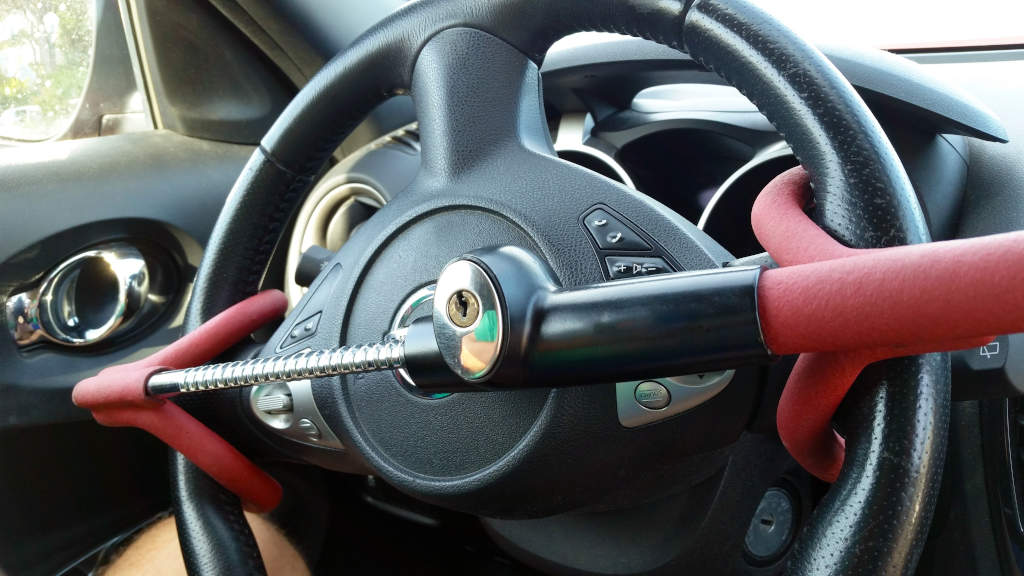Cars are both valuable and a favorite target of criminals. Prowls and break-ins are the most common crimes in America and auto theft rates are skyrocketing. You’re at even more risk without an alarm or security system. But if you own one, it can do more than protect you from criminals. You can also qualify for the auto insurance anti-theft device discount.
People who own vehicles with crime-stopping measures are less likely to file insurance claims. That’s why many insurers offer discounts for car alarms and other anti-theft devices. The savings can be significant. For example, GEICO offers a 23% discount for comprehensive coverage when qualifying security systems are present.
In this article:
- How the anti-theft discount works
- How to qualify
- Types of theft-deterring devices
- How much you can save
- States that require this discount
- Companies that offer this reward
- Savings by company
- Frequently asked questions
How the Anti-theft Device Discount Works
Most auto insurance companies offer a variety of pricing incentives that make coverage more affordable by lowering your rates. Those involving vehicle safety are easy to get, and you probably qualify for several. Most modern cars roll off the assembly line with factory-installed equipment that qualify for discounts, including:
Insurers also love security measures because anything that deters a criminal from breaking into a vehicle or aiding in its recovery saves them money. With forced entry and vehicle-related crime increasing nationwide, more and more insurance companies offer discounts to customers who install car alarms, kill switches, wheel locks, and GPS tracking systems.
Qualifying for the anti-theft discount is a snap if your car has a device or alarm system that prevents forced entry. Equipment that helps law enforcement find and recover a stolen vehicle can also qualify.
How to Qualify
There are a couple of different way to qualify for anti-theft insurance discounts. One is to buy a car with a qualifying, factory-installed device. Many newer models come equipped with crime-preventing tech. To find out if you already have such equipment, give the vehicle’s year, make, and model to your agent. They have more info on security features that meet their standards. Otherwise, you can look the details up yourself online.
Another way to qualify for this discount is to buy and install an aftermarket security alarm or system. Be aware that insurers only accept specific anti-theft devices. So, check with your agent to make sure you install qualifying gear.
Types of Theft-deterring Devices
An anti-theft device is a car alarm system or other security tech intended to deter criminals from using forced entry to steal property. They can be either standard equipment or aftermarket, but most modern vehicles come pre-loaded with something to keep crooks out. Some keep thieves from breaking in, while other devices come in handy with recovering a stolen vehicle.
Anti-theft devices fall into two main categories, active and passive. Each type is effective, yet has entirely different functionalities. You decide the security setup that makes you feel the most secure. You may even add more than one to maximize your protection. However, to get a discount, sure you pay attention to what your auto insurance provider accepts.
Passive vs. Active Devices
When talking about vehicle security and anti-theft devices, it’s important to understand the difference between active and passive devices. Each type is effective and has its pros and cons. But first, we need to define them.
Passive
Passive anti-theft systems arm or activate themselves automatically when you turn your ignition off, remove the key fob, or shut a door. Insurance companies prefer passive systems because they’re easy to use. As long as you don’t deliberately disable them, they run in the background, arming themselves when needed.
Examples of Passive Systems
- PassLock system. A PassLock system cuts the fuel to your engine when the wrong key is detected. This makes it very hard for a thief to steal a vehicle.
- GPS tracker. With a GPS tracker, you can keep tabs on your vehicle at all times via your phone. This can also help you recover your car if someone steals it.
- Automatic locks. These lock your doors automatically when the key fob is far from the vehicle.
- Vehicle recovery system. You can install a recovery system that sends a radio signal to the police if a thief steals your car. The radio signal usually discloses its location, helping police get it back.
Active
Active anti-theft systems, on the other hand, require an action such as hitting a button or placing a locking mechanism on a steering wheel or column for them to work. If you forget to activate it, you won’t have protection. Even so, these are an effective crime deterrent and should help you qualify for lower insurance rates.
Examples of Active Systems
- Car alarm. A loud, audible alarm is a good way to prevent crime. Most vehicles will already have this. There are many types of car alarms on the market, but not all qualify. Check yours to find out if you qualify.
- Steering wheel lock. This is a common crime deterrent. It’s a physical lock you place on your steering wheel so that crooks can’t drive off easily, even if they already broke into it.
- Security tire clamp. This fits around your wheel. It’ll help prevent thieves from stealing your vehicle while it’s sitting in a parking lot.
- Wheel locks. These protect your wheels, tires, and rims from thieves.
- Kill switch. A kill switch will cut the power to your engine to prevent criminals from being able to start it. To install this, you may need to hire an expert, such as a mechanic.
Note that these are some of the most common anti-theft devices. There are many more on the market that qualify. If you have any questions about types of security systems, be sure to contact your insurance provider. They should be able to help you discover what qualifies for a discount and which may not.
After you’ve installed an anti-theft system, you’ll need to prove it to your auto insurance carrier. Your provider should have more info on how to do this. It may be different for each company, but you can often just send a photo through its mobile app. After that, you’ll receive your savings.
How You Can Save
Savings for the anti-theft device discount varies by insurer. A passive car security system saves up to 30% on comprehensive insurance which is very compelling. Less sophisticated equipment can still qualify, but your savings won’t be as dramatic. Even so, most save around 15-20% on comprehensive coverage. In some areas, this significantly reduces premiums.
States That Require Anti-theft Discounts
Several states understand the importance of vehicle security systems and how they help insurers reduce their expenses. These state governments have passed laws requiring providers to pass on some of these savings in the form of an insurance discount on comprehensive coverage to customers whose cars have anti-theft technology.
Below is a list of the twelve states that mandate a discount on comprehensive coverage for certain anti-theft devices:
- Florida
- Illinois
- Kentucky
- Louisiana
- Massachusetts
- Minnesota
- New Mexico
- New York
- Pennsylvania
- Rhode Island
- Texas
- Washington
Companies Offering the Anti-Theft Discount
Many of the largest and most well-known insurance companies offer anti-theft device discounts. Several types of security systems qualify. Each provider will vary in its savings and the equipment it approves. Here’s a list of major insurers that reward policyholders for having stolen vehicle trackers and break-in prevention systems:
- GEICO
- Nationwide
- State Farm
- Liberty Mutual
- Allstate
- USAA
- Farmers
- Dairyland
- NJM
- The Hanover
- COUNTRY Financial
- Mercury
- Shelter
- Amica
- The General
Anti-Theft Device Discounts by Company
| Insurance Company | Max Savings |
|---|---|
| Amica | 35% |
| GEICO | 23% |
| Nationwide | 25% |
| State Farm | 15% |
| Liberty Mutual | 20% |
| Allstate | 10% |
| USAA | Varies |
| Farmers | Varies |
| Dairyland | Varies |
| NJM | Varies |
| The Hanover | 8% |
| COUNTRY Financial | 10% |
| Mercury | Varies |
| Shelter | Varies |
Frequently Asked Questions
Do new cars come with anti-theft systems?
Most new vehicles come with some sort of anti-theft device. You should do some online research on yours and find out exactly what type it has. Smart key fobs and alarms likely come with buying a new car. These alone may reduce your premium.
Older vehicles have fewer security systems than newer ones. The older it is, the less likely it is to have the kind of modern technology that can lock you down a car insurance anti-theft discount. Keep in mind when shopping for a used vehicle that you can install your own after-market system to qualify for this reward.
How do I know if my car has a qualifying device?
Insurance companies accept a wide range of anti-theft devices making it likely your car has at least one. Audible alarms are a very common feature that most insurers should accept. Your vehicle might have another as well. Be sure to ask your agent or provider about your specific make and model.
You may also choose to add after-market alarms or trackers. Before you do, check with your carrier to make sure you install qualifying systems.
What theft-prevention equipment qualifies for a discount?
Which equipment qualifies depends heavily on several factors. For starters, some insurance companies require OEM factory-installed anti-theft devices. Not all do, as some will accept after-market alarms. The best of these will track a stolen vehicle with GPS or disable it. But steering column locks, wheel locks, brake locks, and car alarms qualify, too. There are too many to list here, so check with your agent if you’re unsure.
Is it worth installing a car alarm system to lower rates?
One could argue that it’s worth installing anti-theft devices whether you get an insurance discount or not. There are a lot of pros and only a few cons. Depending on what kind you get, it could help recover a stolen vehicle or deter criminals from even touching your car. The only con worth mentioning is cost.
There’s a wide selection of theft-deterring and vehicle-recovery systems on the market. Simple car alarms cost anywhere from $100 to $300. But if you really love your ride, or have a valuable asset to protect, a GPS recovery system costs $50 or so just to install and then $9.95 to $49.50 a month.
If that seems like too much for how much it saves you, ask yourself how much you value your possessions. That should help you make the right choice.


